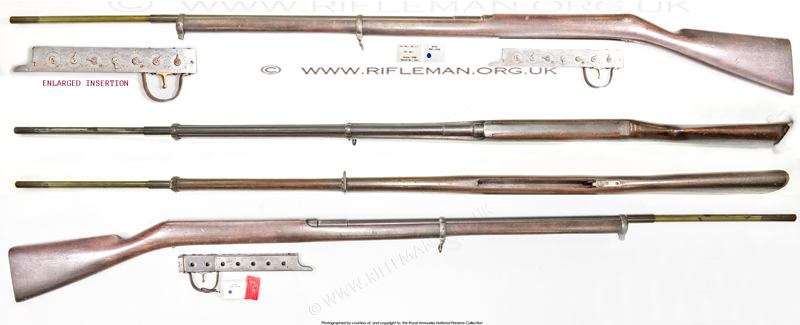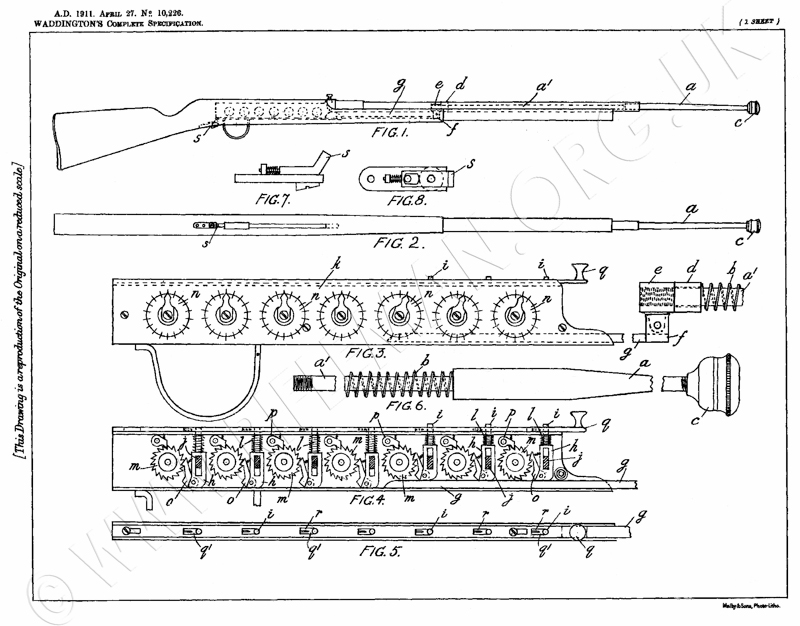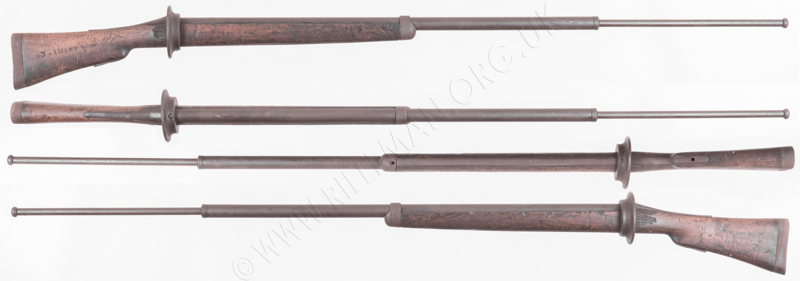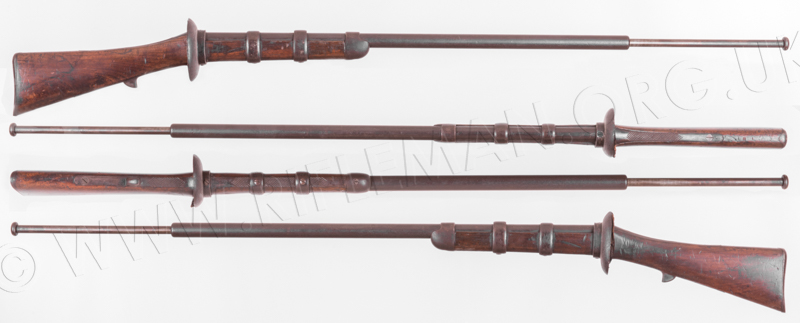BEST VIEWED ON PC.. - ....FREE OF COOKIES, TRACKING & ADVERTISEMENTS
THE FENCING MUSKET
Please be aware that some specialist imagery may take time to load.
This site is designed for dedicated researchers, and is best viewed on desktop.
See also: DUMMY TRAINING RIFLES
The earliest formal introduction of a spring-bayonet fencing musket was in 1863, when approval was given for a design submitted by Wilkinson & Son for a musket suitable for use "in gymnasiums".
The "spring" for the bayonets was, until a modification, often made of India rubber. Perishing rubber, shortening the telescoping length and hardening of the thrust, necessitated the alteration to helical steel springs approved by a List of Changes (LoC) entry No. 5770 of 13th. March 1889.
Replacements were made as originals became unserviceable.
The Royal Armouries in Leeds, now custodians of the collection from the old Enfield Pattern Room, hold this Sealed Pattern Rifle, of 1863 date, that has a solid "bayonet" attached to the RHS of the barrel, and to the original bayonet lug of the nose-cap. The "blade" is made with a mushroom head rather than a separate round "button".
Illustrated by kind permission of the Trustees.

Another early version of fencing musket was manufactured by the Wilkinson Sword Company from the stock of a standard Pattern 1853 rifle.
The example shown here is the original sealed pattern rifle once held in the Enfield Pattern Room, also now at the Royal Armouries in Leeds.
Zooming in to the right hand side of the musket in the upper image will show the twin red wax seals that confirm it as the sealed patter example with which all subsequent production was required to conform.
The "barrel" was a plain tube that carried the spring and plunger for the button-ended "bayonet".
There being no upper handguard, it was necessary to reinforce the fore-end woodwork foreward of the middle barrel band.
Three steel strips were let into the wood between the barrel band and the nose-cap; one strip either side, and a third underneath.
In use, these muskets took quite a beating, and the strengthening was insufficient to prevent the upper edges of the fore-wood from splitting away. pub.
Following on was the 2nd. Model dated by the Pattern Room for 1867 as Object no. PR.5538, with the steel spring modification of 1889. The top musket below is by Wilkinson, and the near identical one underneath is of the Wilkinson Pattern by Andrews, Obj.no. PR.5539.
Close-up images of the of PR.5538 show the fittings, including the false hammer, main brass barrel-band, the bayonet slider and the tension 'recoil' spring is just visible in the slot forward of the slider.
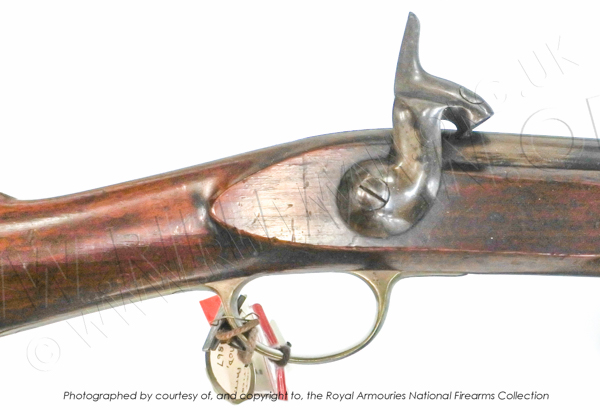


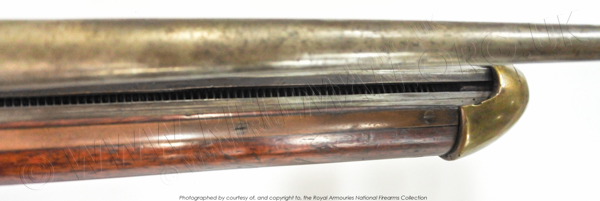
The 'bayonet' blade was a fine product of the Wilkinson Sword Company who, many years later were to produce the Second World War 'Fairbairn Sykes' commando knife under the guidance of Jack Wilkinson Latham, whose surname was cast into the musket's blade nearly sixty years earlier.

A very basic model held at the Royal Armouries is shown next.
It is the Fencing Musket Mk.V with spring bayonet, initially to LoC no.8369 of 3rd. June 1896, and subsequently a second mark to LoC no.9982 of 30th. November 1899 - for Land Service.
Overall length: 1560 mm ; Weight: 4.76 kgs.
The one-piece musket body is made of ash.
The cast hemisphere originally supported an india rubber ball, held in place by the sock of hessian secured to the hickory wood bayonet with string.
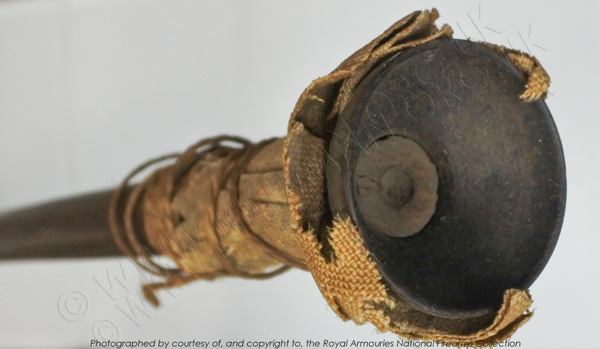
The List of Changes no.9982 detailed its adoption as follows:
Strengthened bayonet. With reference to LoC 8369: in future manufacture, muskets of the above mentioned description will have bayonets made of stronger steel. A pattern of musket with strengthed bayonet has been sealed in substitution for that previously sealed as Mark V. The change will not involve any advance in numeral. Mark V muskets returned for repair will be fitted with the strengthened pattern.
A pattern of the above-mentioned musket has been sealed to govern future manufacture. Exisitng gloves, muskets and pads will be used up. They differ from the previous patterns, LoC 6664 and 9982 in the following particulars: The gloves are not fitted with holes in the palms, thay are also lighter in weight, being 1lb 5oz per pair instead of 1lb 8½ oz. The musket consists of a butt portion or stock of ash, 3 feet 9 inches in length, and bored at the barrel end to a depth of 2 feet 7½ inches into which is fitted a steel tube, threaded on the inside for the purpose of securing a brass cap, whcih in turn holds a spiral spring 2 feet 6 inches long (when released), n position and admits of he free movement of the bayonet portion in the steel lining. The bayonet is made of hickory wood and is 19 inches long and ⅞ inch in diameter, and is kept in posiiton in the stock by a piece of steel tubing secured at the back end, which buts against the steel lining of the brass cap when not compressed in use. On the front end of the bayonet a steel cap, 1 ¾ inches in diameter is secured which holds the indiarubber ball, whcih is also 1¾ inches in diamter, the latter is covered with linen and secured to the end of the bayonet with string. The pads are hollowed out at the sides so as to fit close into the thighs, they are also lighter in weight, viz., 1lb 1½ oz each instead of 1lb 6½ oz.
The last sentence mentioning pads relates to the body armour approved in the same list change, along with heavy protective gloves.
This pattern of fencing musket was in use up to the introduction of the Mk.VI on 3rd. October 1902, at the time of the Boer War. That LoC, no.11489, for the Mk.VI varies not a whit from that of the Mk.V, and despite the earlier mention of a possible modification to a steel bayonet, the hickory wood one was retained.
At that time in 1902, the introduction of the Mark VI continued the use of ash wood, whereas prior to the Mk.V walnut had been specified.
A further model, given the nomenclature " Musket, fencing, short (Mark I), was approved and a pattern sealed on 14th. November 1904 by LoC no.12764. which included a spanner for replacing parts and stated:
Musket, fencing, short (Mark I). With spring bayonet and india rubber pad. Spanner (mark I). Steel; removing and replacing barrel bush and bayonet button, Musket, fencing, short.
A pattern of the above-mentioned musket has been sealed to govern future manufacture. The exisitng stock of O.P muskets will be used up. The new pattern musket in length, weight and balance is similar to the "Rifle, short, M.L.E., with sword bayonet". It differs from the "Musket Mark V" described in LoC 8369, 9982, in the following particulars - the barrel is plain tube, withut studs, tapped at the front end to receive the barrel bush which is removable. The barrel bush is screwed into the barrel by the milled head, across which flats are cut for the spanner. The hand guard is in two pieces, top and bottom, and is held in position by two screws, one on either side; a third screw passes through the top portion of the hand guard, barrel, and stock, and is screwed into the bottom portion of the handguard, locking the whole together. The stock, butt, is provided with a pistol grip, similar to the "rifle, short, M.L.E." there are no straps fitted to the stock. The bayonet spring is 4 inches shorter with 68 coils. The diameter of he head of the bayonet button is larger. The entrance hole in the pad is smaller giving a better hold for the pad on the button. The spanner is provided for removing and replacing the barrel bush, and is fitted with two pins for removing and replacing the bayonet button.
Total length of musket (over all) 4ft 8 11/16 ins.
Total weight of musket (over all) 9lb 8oz.
Balance from end of butt 23½ ins.
This short version was to provide a representation of the just introduced (Rifle, Short, Magazine, Lee-Enfield), also then known as the "new Short Rifle".
In addition to the purpose-built muskets here illustrated, in September 1907 another completely new model was approved - the Mark II version of the Musket, fencing, short.
This was a conversion of the Martini-Henry rifle, itself already having been superseded by the bolt-action Magazine Lee-Metford/Enfield long rifles and, indeed, the even more recently introduced and just mentioned S.M.L.E..
Being of similar overall length to the latter weapon, the Mk.VII fencing musket was also issued to units holding the then comparatively new "Short" rifle.
Below: the drawing of the Martini Henry model of fencing musket
as shown in the List of Changes - LoC 13991 - of 28th. September 1907.
13991—Musket, fencing, short (Mark II)
Converted from Rifles, Mk.II. With spring bayonet, but warmer india-rubber pad. A pattern of the above-mentioned musket has been approved to govern conversion as may be ordered.

It is similar to the Rifle, Short, M.L.E., [S.M.L.E.] with bayonet, in length, weight and balance. The conversion is made from M.H. rifles, and consists of the following—
The action is removed from the body and the space filled with a wood block.
The barrel is shortened and smoothbored to receive the bayonet spring A and bayonet B, and is fitted with a nosecap C, into which a bayonet stop bush D is screwed. The barrel is hardened and spring tempered.
The bayonet is of steel, hardened and tempered, and is fitted with a
screwed steel cap E (instead of an india-rubber pad) which is screwed on the end of the bayonet and fixed by a crosspin F. A balance weight is fitted in the stockbolt hole of the stock butt.
Total length of musket (over all) ................................ 4 ft. 10⅛ ins.
Total weight of musket................................................. 8 lb. 10 ozs.
Balance from end of butt ............................................. 24 Inches.
The example below is Object no.P.R.5541 at the NFC.
It was converted from a Victorian Enfield MK.III of 1875
A further modification was approved in the LoC no. 14470 of6th. November 1908.
Musket, fencing, short (Mark II). Converted from rifles M.H. with spring bayonet, but without india-rubber pad
With reference to LoC 13991 - muskets of the above mentioned pattern will in future be fitted with a strengthened bayonet, and with a lower band, screw and pin 7 inches from the front of the body.
1. In future manufacture the portion of the bayonet screwed for the receieving cap will be partly screwed and partly plain, with a radius in the corner to prevent breakage at that point. The cap will be correspondingly altered to suit the bayonet. For the purpose of identification these bayonets and caps will be known as No.2, and will be marked with the figure "2".
2. Muskets in store and in the hands of troops will be fitted locally with the lower band, pin and screw by Army Ordnance Department or regimental armourers in the following manner. Remove the nosecap screw and pin stud barrel; drive the fore-end with drift fore-end until clear of the body, and then pull the fore-end back clear of the nosecap. Open the band wide enough to pass over the barrel and then close it to its original shape. Replace fore-end and barrel stud pin. Mark off the position of the band on the fore-end 7 inches from the front of the body, and with the "saw, slitting 7⅛ inch" cut around the fore-end to a depth of about ⅛-inch, and with chisel and files remove the wood and fit the lower band (a few light taps with a wood mallet will make the band fit the barrel); then screw home the band screw. With an "awl, blade, armourers" of suitable size bore a hole for the lower band stop pin, and insert the pin.
Ordnance Officers and Officers Commanding will demand the following components for fitting to each musket - Band, lower, M.H.; Pin, stop, band,lower, M.H.; Screw, band,lower, M.H. For Naval service the bands will be fitted to the muskets in accordance with directions that have been issued by the Admiralty.
A privately held example is a conversion of an 1876 Mk.II service rifle,
and has a brass fitting holding the bayonet tube rather than the steel one of the Royal Armouries pattern.

A wood insert is used in the emptied receiver body.


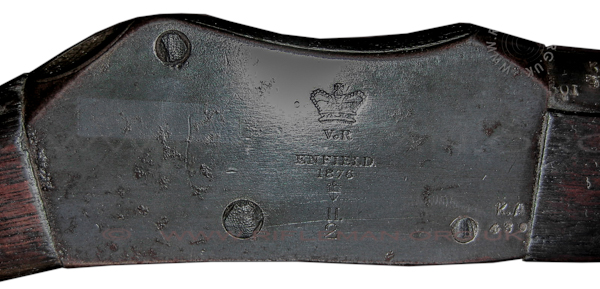
In its service lifetime, this rifle found its way to India; being stamped with the cartouche of the Kirkee Arsenal.
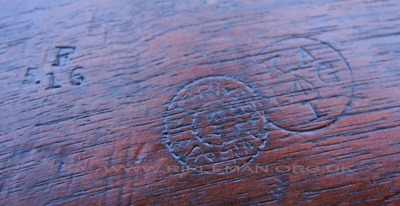
A further similar conversion of the Martini-Henry, approved on 26th. March 1909, became the "Musket, fencing, Mk.VII" . That list change, no. 14757, stated:
Converted from Rifle, M.H., with spring bayonet, but without india rubber pad. A pattern of the above-mentioned musket has been approved to govern conversion as may be oredered. It differs from the Musket, fencing, short, Mark III'' described in LoC 13991 and 14470, in the following particulars -
The barrel and fore-end are left 3⅜ inches longer to make the musket equal in length to the short rifle with the pattern 1907 sword-bayonet fitted. The nosecap is screwed on the barrel and fixed by a pin passing through the nosecap and the underside of the barrel.
Total length of musket (over all) ................................5 ft. 10½ ins.
Total weight of musket................................................. 8 lb. 14 ozs.
Balance from end of butt ............................................. 24 Inches.
Ironically, and in typically complicatedand hugely thorough military fashion, on the same date. 26th. March 1909 List of Changes no. 14902 added a further modification, and cancelled LoC no. 14575. It may perhaps help an avid collector discover what is missing from, or how to repair, his valued example! It may at least assist in discovering the correct mark of a musket.
It read:
Musket, fencing (Mark VII). Converted from Rifle M.H., with spring bayonet, but without india rubber pad.
New Pattern.
LoC 14757 cancelled.
A pattern of the above-mentioned musket has been approved to govern conversion as may be ordered. It differs from the "Musket, fencing, short, Mark II" described in LoC 13991 and 14470 in the following particulars. - The barrel and fore-end are left 3⅜ inches longer to make the musket equal in length to the short rifle with the pattern 1907 bayonet fixed. The nosecap is screwed on the barrel and fixed by a screw passing through the nosecap and bayonet bush into a recess in the top side of the barrel. The metal of the nosecap is expanded into the slot of the screw by a centre punch to prevent the screw working loose. The chamber of the barrel is fitted with a wooden plug in two parts to enable the bayonet spring of the "Musket, fencing, short, Mark II" to be used. The following is a list of components, showing which are special to this musket, and whch are common to other arms. Those which are common to other arms are denoted by the word "Common" and their interchangeability is as stated in the "Priced vocabulary of Stores" etc.
LoC 14757 is hereby cancelled.
COMPONENT ........................................ .......................... ............ REMARKS
Balance, weights, musket, Mark VII: .........................Special.
Bands,lower,musket, short, Mark II:..........................Common.
Barrels, musket Mark VII: ........................................Special with body (with wood blocks and fixing pegs); nosecap and screw; bush, stop bayonet .......................... .......................... .......................... ...and fixing screw, and plugs, barrel.
Bayonets, musket, short, Mark II No2: ......................Common with cap and fixing pin.
Blocks, wood, body, musket, short, Mk II, No.2: ........Common not issued separately.
Bodies, musket, short, Mark II: ................................. Common with blocks, wood (in 2 parts) and 4 fixing pegs. Not issued separately.
Bolts, stock, musket, short, Mark II: ...........................Common.
Bolts, stock, musket, short, Mark II. ...........................Common.
Bushes, stop, bayonet, musket, short, Mark II, No.2. ..Common, not issued separately.
Caps, bayonet, musket, short, Mark II, No.2. ..............Common, not issued separately.
Caps, nose, musket, Mark VII. .................................... Special, not issued separately.
Pins, musket, fixing, cap, bayonet, short, Mark II. .....Common.
Pins, musket, stop, band, lower, short, Mark II............Common.
Pins, musket, stud, barrel, short, Mark II. ...................Common.
Plates, butt, musket, Mark V. ....................................... Common.
Plugs, barrel, musket, Mark VII (2). ............................ Common.
Screws, musket, band, lower, short, Mark II..................Common.
Screws, musket, butt plate, Mark V (2)...........................Common.
Screws, musket, cap, nose, short, Mark II. ....................Common.
Screws, musket, fixing, bush, stop, bayonet, Mark VII. .Special.
Springs, bayonet, musket, short, Mark II. ......................Common.
Stocks, musket, butt, short, Mark II. ..............................Common.
Stocks, musket, fore-end, Mark VII. .............................. Special.
Stops, stud, musket, barrel, short, Mark II.....................Common.
Washers, bolt, stock, musket, short, Mark II. ................ Common.
..........................The final act in the saga of fencing muskets converted from obsolete Martini-Henry rifles was enacted just seven months later, with the issue of LoC no. 14903, dated 26th. October 1909. This notified of a number of alterations to nomenclature, required the using up of existing stocks, and cancelled LoC no.14756.
It stated:
Muskets, fencing - with spring bayonet.
Mark IV with india rubber pad.
Mark V with india rubber pad.
1. Altered nomenclature. Muskets - fencing with spring bayonet. Mark IV with indiarubber pad - L; Mark V with indiarubber pad - L; Mark VI wood, with indiarubber ball - L; Short- Mark I with indiarubber pad - L; Mark II converted from rifles M.H. without india rubber pad - C.
2. To be used up.
1. The nomenclature of "Muskets, Marks IV and V" described in LoC 7406 and 8369, will, in future be shown as above.
2. Muskets, fencing, of the above captioned pattern will be used up before taking into use the Mark VII pattern described in LoC 14902.
LoC 14576 is hereby cancelled.
Below: the 2nd. Battalion of the Durham Light Infantry, Cork- ca. 1908

The Mark VIII and IX muskets were both introduced in April 1912.
The former being a conversion of the Rifles, M.E., Mks.II & II*,
whilst the latter was converted from the Magazine Lee-Metford Mk.I*.
An additional new pattern, notated the Mark X,
was approved on 28th. August 1913, within sight of the Great War.
The Marks IV and V muskets were declared obsolete in October 1909.
By 1925, all Marks to IX had been declared obsolete,
with only the Marks X, No.1 and No.2 remaining in service.
Immediately prior to the introduction of the Mark VIII and IX muskets, a particularly unusual and sophisticated prototype was designed, and in 1911 patented, by Benjamin Cowper Waddington.
The musket incorporated a mechanical system, akin to an early computing machine, that recorded the pressure applied by a thrust.
The only know example of this 'training weapon' lay in the old Enfield Pattern Room collection, now at the Royal Armouries.
The recording machinery remains hidden when the musket is in use, but can be removed to view the seven rotatry counters, each calibrated from zero to seventeen.
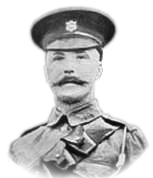
Ben Cowper Waddington was born in 1878 at West Hartlepool, Durham. He was the son of Ben Cowper, a plumber, and Annie Waddington.
At the time of the patent application, Ben, then 33 years of age, as recorded in the 1911 census, had moved to Hillsborough, Sheffield. He had remained single, and his occupation was described as soldier. He had married just one year later. In his pre-war patent application he describes himself as a plumber and gas fitter, as was his father, but he may well then also have been a member of a Volunteer Regiment.
Sadly, Cowper Waddington was killed in France on 1st. September 1914, early in the First World War, whilst in action with the 3rd. Battalion of the Coldstream Guards in a rear-guard movement during the Retreat from Mons at le Foret de Retz. He lies nearby in the Guards' Grave at the Villers Cotterets Forest, Aisne. His death, along with economics of production, limited perceived usage and the war situation, were very likely to have been reasons for the lack of progression of his innovative design.
The zoomable Patent Drawing is shown below.
The complete patent application document of 26th. April 1911 is replicated here.
The application was made on Waddington's behalf by his agents, R. Heber Radford, son and Squire of Sheffield.
It should be noted that, whilst the prototype musket carries a manner of trigger, it is not anticipated that one would be fitted for production models, as it is not evident in the drawings. The trigger of the prototype is simply a means of zeroing the dials, which would not be available to users in training.
In the patent text there is mention of 'windows' in the side of the musket's furniture that would permit the taking of readings without removing the recording unit. It appears that the dials were eventually intended to reset with each thrust.
The assertion that the musket is safer to use than the standard then currently used models with sliding sprung 'bayonets' is interesting, in that this musket could still presumably suffer the sticking of the slide that is implied as causing injury when the already issued models jam in use.
However, it could certainly record the pressure applied were any such injury to be caused.
Another sealed pattern musket held at the Royal Armouries is the Mk.IX, Object no. PR.5551.
It is a conversion of a Magazine Lee-Enfield (the original "Long-Lee").
The bolt-less action, viewed from above, with original marks remaining


The List of Changes reference for the Mk.VIII and Mk. IX rifles was no. 16121 of 26th. March 1912.
It read:
Muskets, fencing- with spring bayonet.
Mark VIII converted from rifles, M.L.E. [Magazine Lee-Enfield] Marks II and II*,
Mark IX converted from rifles M.L.M. [Magazine Lee-Metford] Mark I*.
A pattern of the above-mentioned musket has been approved to govern future conversion as may be ordered. The conversions are made from Rifles, M.L.E., Marks II and II* and Rifles M.L.M. Mark I*, respectively, and consist generally in smooth boring the barrels, cutting the barrels and fore-ends to a suitable length, and fitting a nosecap, bayonet and spring, similar to those of the muskets described in LoC 13991, 14470 and 14902, but differing in certain details. The bayonets of these muskets are provided with a spring expanded stop, fitted in a rectangular slot at the bottom end of the bayonet, instead of solid stop collars as in previous patterns. The bayonet cap is fixed by a parallel, instead of taper pin. The ends of the pin should be lightly rivetted over when replaced.
Total length of musket (over all) 4ft 8 11/16 ins.
Total weight of musket (over all) 9lb 8oz.
Balance from end of butt 23½ ins.
Mark VIII: Total length of musket (over all) 5ft 11½ ins.
Total weight of muskets 9lb 2oz.
Balance from butt end 24 in.
Mark IX: Total length of musket (over all) 5ft 1½ ins.
Total weight of musket (over all) 10lb 1½ oz.
Balance from end of butt 24 ins.
The followiing is a list of components which are special to these muskets and which are common to other arms; those which are common to other arms are noted as such in the remarks column, and their interchangeability is as stated in the Priced Vocabulary of Stores...
The follow-on two pages of the above entry provide another lengthy list of parts of either special or common status;
equivalent to that already shown for the Martini-Henry conversions.
An unidentified fencing musket lies in the old Pattern Room Collection at the Royal Armouries.
Object no. PR.5558, it has no date estimate nor manufacturer information.
We show it here lest a reader is able to identify it.
It is a particularly well-made piece, finely finished, and with brass fittings.
An unusual conversion of the Short Magazine Lee-Enfield is shown next.
This is an ex. Enfield Pattern Room example now held at the Royal Armouries as Object no. P.R.9529; although their online catalogue shows it incorrectly as a shotgun conversion of a B.S.A. manufactured Mk.III S.M.L.E., but the tag attached by the late Herbie Woodend in the original Pattern Room describes it as a conversion for bayonet practice as part of a contract for the Portuguese military.
The brass butt disc is engraved "C. MARINHEIROS"; presumably a marine contingent.
The action, bolt open, with bayonet coil spring showing.
Even the magazine cut-off remains in place.

A near identical rifle converted to a fencing musket was also
originally a commercial model manufactured by the Birmingham Small Arms Co.,
and it is possible, but not confirmed, that these conversions were done by the factory. The rifle came up for sale with a North American dealer.

Images by courtesy of Joe Salter.
The "barrel" has been increased in diameter to accommodate the bayonet rod.
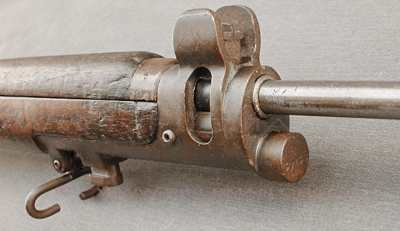 ...........
...........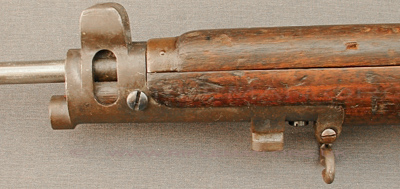
Below left: the butt disc carries the marks " "G. VELHO"
'Velho' is Portuguese for 'old', or 'old man', and may simply be an user's name, unless you know differently.
Right: the plain mark on the butt-socket's RHS of "B.S.A. Co."
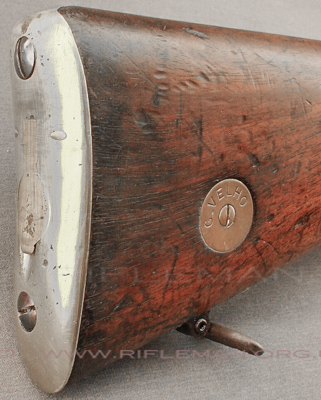 ...........
...........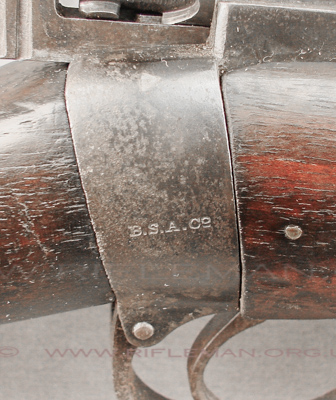
The action and bolt appear as original.
The necessary large radiussed "button" is screwed firmly to the end of the bayonet rod.
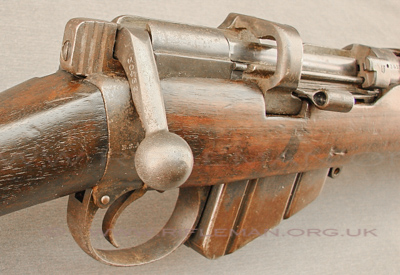 ...........
...........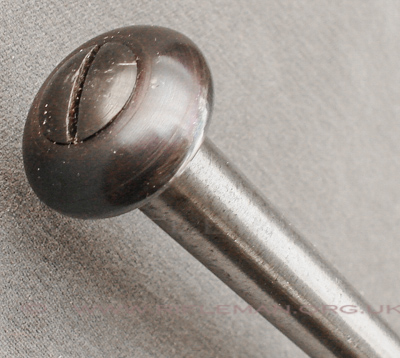
The style of musket with handguard, shown in the images below, was initially introduced, as the Mk.IV, in 1894, (shortly after approval of the Martini-Henry Service Rifle), and was amended, with small modifications, to the Mk.V in 1896.
The Greener Company manufactured many rifles and shotguns, but one of their lesser-known wartime products was their fencing musket.
These "weapons" continued the series of devices used for bayonet and hand-to-hand fighting practice.

Two versions are illustrated above. The upper, longer, example is the W.W. Greener product. Muskets of this pattern were also made by the other well-known gunsmiths C.G. Bonehill.
The lower musket is completely unmarked and was previously of unknown manufacture,
as quite a number of manufacturers were contracted to build these training devices.
We have recently been passed detail of an identical musket carrying a manufacturer's cartouche, and this is show a little further down the page.
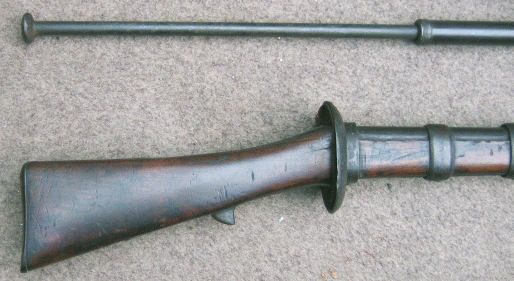 ......
...... 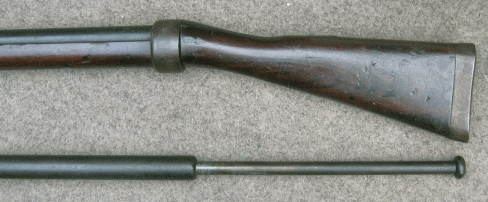
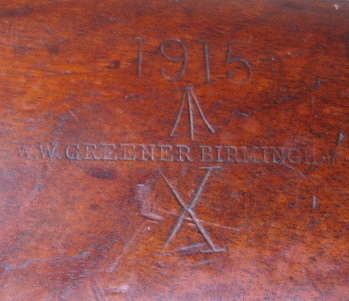
The Greener model is straight-stocked and plain,
whilst the lower model has a hand-guard and under-lug to prevent the hand slipping back .
The button-ended dummy bayonet is spring-loaded and retreats into the musket body when pressed against an object.
There is no difficulty in dating the Greener musket, for they have seen fit to mark the butt-stock very clearly on the LHS
with the year of manufacture and their company name and factory address.
1915 is the date - one year into the Great War, and the Government's War Office "Broad Arrow" mark is most prominent.
Further imagery of the musket sans hand-guard is shown below.
The 1915 dated and heavily used musket shown below is marked on the butt to the Honourable Artillery Company.
Behind the hand-guard the wrist of the stock has a notably cut-away hand-hold.
Fencing muskets such as these are shown in use in the following two images, along with the helmets, gloves and body armour already mentioned.
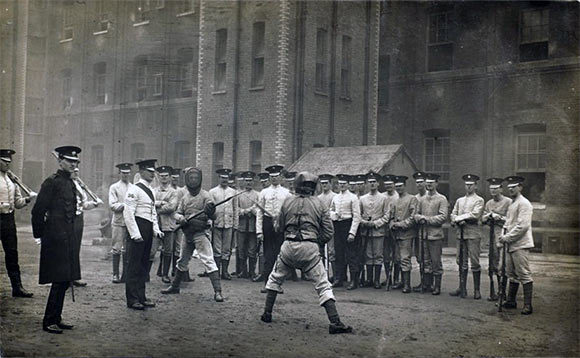
The 'combatants' in both these photographs are using the muskets fitted with the cast hand-guards that usually have a leather internal lining.
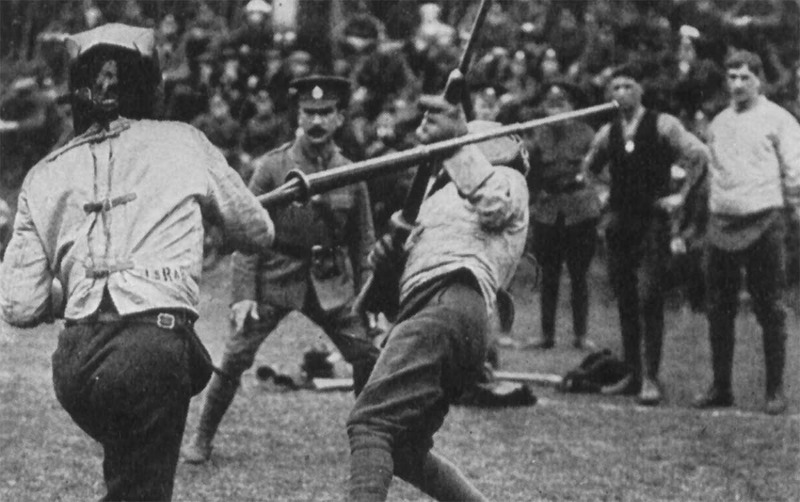
This more substantial example has additional mighty 'barrel' bands and a relatively costly chequered steel upper and lower
strengthening tang behind the hand-guard with an attached lug under the butt to prevent rearward hand slippage,
As already mentioned this example is unmarked, and the manufacturer was previously unknown;
but a reader owning an identical model has kindly passed a photograph of the cartouche stamped into its butt-stock;
this is shown beneath our four-view image of the musket.
We now know that the above musket was manufactured by the company Spencer, Heath & George Ltd., of London.
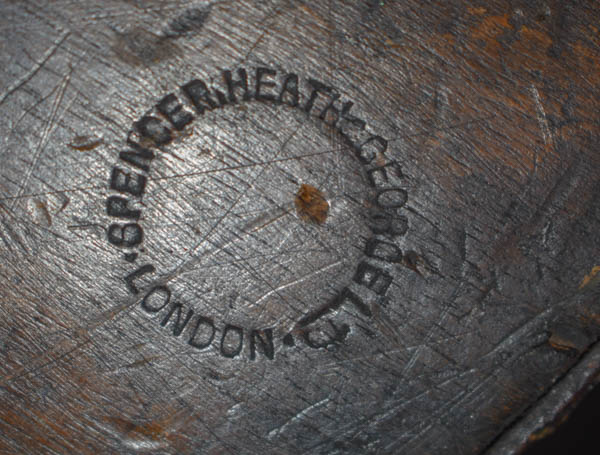
The company produced all manner of sports equipment from the beginning of the Twentieth Century up until the mid 1950s.
Indeed, they furnished the gymnasia on several famous Cunard liners, including the Queen Mary, Aquitania and even the ill-fated RMS Titanic.
_____________________________________
The last List of Changes approval entry associated with fencing 'muskets' was no.17503 of 17th. September 1915.
Musket, fencing, Mark X, No.2. With spring bayonet, without rubber pad.
1. New Pattern. Musket, fencing, Mark X, No.1. With spring bayonet, without rubber pad.
2. Change of nomenclature.
1. A pattern of the above mentioned musket has been approved to govern supplies as an alternative to the musket described in LoC 16547, so as to enable the muskets to be more readily produced by certain manufacturers. It differs from the musket described in LoC 16547 as follows.- The top and bottom straps are held to the stock by commercial wood screws screwing into the wood of the stock, instead of the straps being tied together by a single screw passing through the bottom strap and screwing into a boss on the top strap. The butt plate screws have a commercial thread, instead of that common to all rifles and carbines. The following is a list of components showing whcih are common the the No.1 musket and which are special to this musket. The remainder is a list of parts and special/common status. Spare bayonet buttons will be fitted to bayonets and vice versa, as follows: Having removed the keeper screw from the spare button, screw the button home into the bayonet, mark the position for the screw point recess on the bayonet, remove the button from the bayonet, and cut small groove across the top edge of the bayonet with a round file. Screw the button home in the bayonet (observing that the screw enters the groove in the bayonet fairly), and file the screw point flush with the bayonet, and head of the screw flush with the top of the button.
2. In consequence of the introduction of the No.2 musket, the nomenclature of the musket described in LoC 16547 will be as now shown.
As mentioned, muskets of the Mark X type were announced in the List of Changes no. 17503 of 17th. September 1915.
LoC entry no. A921 of 3rd. April 1925 declared the withdrawal of all earlier muskets from service.
Muskets, fencing- Mark lV, Mark V, Mark Vll, Mark Vlll, Mark lX, Short Mark l, Short Mk ll. Obsolete.
Muskets of the above-mentioned patterns are hereby declared obsolete.
Exisiting stocks may be exchanged, on demand, for Mark X, No.1 or Mark X No.2 (LoC 17503)
Nonetheless, fencing muskets, to these approximate designs were made by gunsmiths such as W.W. Greener,
Webley & Scott and Westley Richards were produced right up to the end of the Second World War.
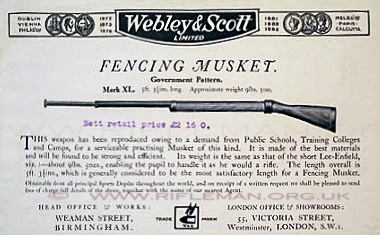
At what must be practically the end of the line for such fencing muskets,
is the Westley Richards' model below.

The butt is provided with an even sturdier steel butt-plate than that of a standard issue rifle.
Being a product of the Westley Richards Co. Ltd., it is so marked.
along with the date of "1944",
and the model "No. 3".
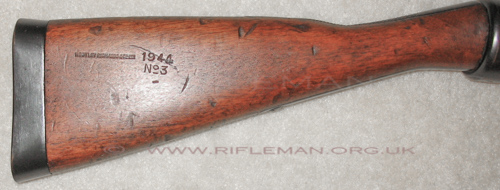
As far as we are aware, bayonet practice with the current SA80 bull-pup rifle is limited to the classic rundown with the service rifle (bayonet fitted, of course) to attack the equivalent of what used to be a straw-filled dummy, as has been well demonstrated in a number of episodes of the "Dad's Army" television series. We are not aware whether hand-to-hand bayonet fighting is practiced, but it is not unlikely.
Whether there are still any dummy rifles employed for such hand-to-hand practice we would be grateful to hear.
If you know something of this, please advise us a.s.a.p!
As a parting 'shot', there was at least one design of sprung bayonet made for fencing practice. Supposedly for an Enfield Pattern '17 rifle, the 'spring' capability was simply a bending movement, and that in only the vertical plane. The leather covered button offered very limited protection from an enthusiastic thrust; perhaps why this is such a rarely seen device. It would also appear that the foresight would have needed to be removed before the bayonet could be fitted.

See also the W.W. Greener Martini Rifles.
Click here to access a Chronology of Enfield genre Training Rifles, Adapters & Cartridges
Return to: TOP of PAGE
See this website's Raison d'être




